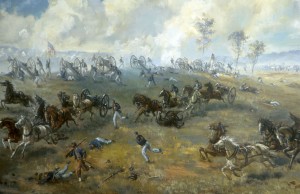
“The Capture of Rickett’s Battery” by Sidney King, 1964 (oil on plywood). On display in the Henry Hill Visitor Center at Manassas National Battlefield Park.
This will either be fun, or go over like a lead balloon. As you may or may not know, one of the things I find most interesting in researching the First Battle of Bull Run is the fact that contemporary documents do not always support the contentions – statements of fact, even – of historians of the battle. The other day, friend and artillery guy Craig Swain and I were discussing the move of Ricketts’s and Griffin’s batteries from their positions north of the pike to Henry Hill. This move has often been criticized over the years, sometimes even described as a turning point of the battle. But, why exactly did McDowell send his artillery there? What was he thinking? How did he want to uses them, as flying artillery, in place of infantry, as what?
Your mission, if you choose to accept it, is to take a look at the evidence. Were written orders issued? What did the actors say about the move later? What have historians said? I’ll even help you out. Below are the reports and testimonies of the four individuals who may or may not have known. Read them over. Look for the why. Check what they presented against what historians have written (you’ll have to use your own resources there.) How have the historians substantiated their assertions? Discuss in the comments section.
BG Irvin McDowell, who issued the order (Reports and Correspondence #1, and #2, and JCCW testimony #1, and #2.)
Maj. W. F. Barry, to whom McDowell issued the order, and who forwarded it to the battery commanders (Report, JCCW testimony)
Capt. Charles Griffin (Report, JCCW testimony)
Capt. James Ricketts (Report, JCCW testimony)

Recent Comments